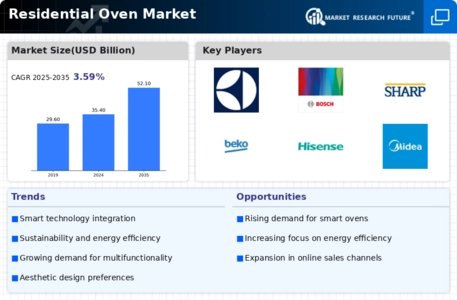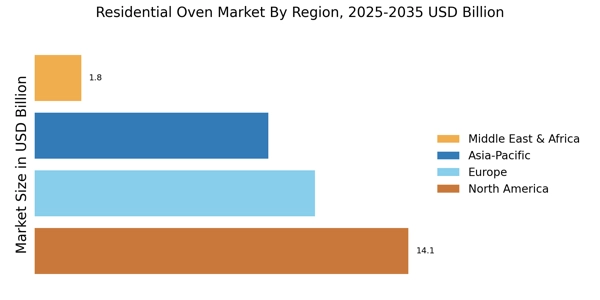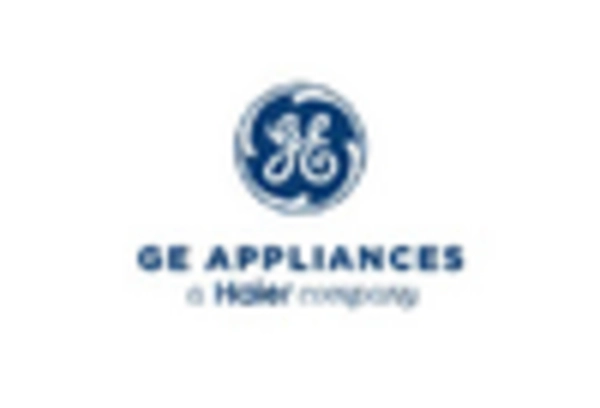Health and Wellness Trends
The growing emphasis on health and wellness is significantly influencing the Residential Oven Market. Consumers are increasingly inclined towards cooking at home, driven by a desire for healthier meal options. This trend has led to a rise in demand for ovens that facilitate healthier cooking methods, such as steaming and air frying. Market data suggests that ovens equipped with these features have seen a 30% increase in sales over the last year. As more individuals become health-conscious, the demand for appliances that support nutritious cooking is expected to grow. Manufacturers are responding by developing ovens that not only cater to these preferences but also incorporate advanced technology to enhance cooking efficiency, thereby aligning with the health and wellness movement.
Rising Consumer Demand for Convenience
The Residential Oven Market is experiencing a notable increase in consumer demand for convenience-driven appliances. As lifestyles become busier, consumers are seeking ovens that offer time-saving features such as pre-programmed cooking settings and self-cleaning capabilities. This trend is reflected in market data, which indicates that sales of multifunctional ovens have surged by approximately 25% over the past year. The desire for ease of use is prompting manufacturers to innovate, leading to the introduction of models that integrate smart technology, allowing users to control their ovens remotely. This shift towards convenience is likely to continue shaping the Residential Oven Market, as consumers prioritize products that enhance their cooking experience while fitting seamlessly into their fast-paced lives.
Changing Culinary Trends and Preferences
The evolving culinary landscape is a significant driver in the Residential Oven Market. As consumers become more adventurous in their cooking habits, there is a growing demand for ovens that can accommodate diverse cooking styles and techniques. This trend is reflected in the increasing popularity of specialty ovens, such as those designed for baking, roasting, or grilling. Market data shows that sales of these specialized ovens have risen by approximately 15% in the last year. As culinary preferences shift towards more complex and varied cooking methods, manufacturers are responding by developing versatile ovens that cater to these needs. This adaptability is likely to enhance the appeal of the Residential Oven Market, as consumers seek appliances that can support their evolving culinary aspirations.
Sustainability and Eco-Friendly Practices
Sustainability is becoming a pivotal driver in the Residential Oven Market. As environmental concerns rise, consumers are increasingly seeking energy-efficient appliances that minimize their carbon footprint. The market has witnessed a shift towards ovens that utilize sustainable materials and technologies, with energy-efficient models accounting for nearly 40% of total oven sales in recent years. This trend is likely to continue, as consumers become more aware of their environmental impact. Manufacturers are responding by innovating and producing ovens that not only meet energy efficiency standards but also promote eco-friendly practices. This focus on sustainability is expected to play a crucial role in shaping the future of the Residential Oven Market, as consumers prioritize environmentally responsible choices.
Technological Advancements in Cooking Appliances
Technological advancements are significantly transforming the Residential Oven Market. The integration of smart technology into cooking appliances is reshaping consumer expectations and preferences. Ovens equipped with Wi-Fi connectivity, voice control, and app integration are becoming increasingly popular, as they offer enhanced convenience and control. Market data indicates that smart ovens have experienced a growth rate of approximately 20% in sales over the past year. This trend suggests that consumers are willing to invest in advanced cooking technologies that simplify meal preparation. As manufacturers continue to innovate and introduce new features, the Residential Oven Market is likely to see further growth driven by the demand for technologically advanced cooking solutions.


















Leave a Comment